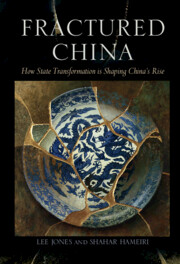Book contents
- Fractured China
- Fractured China
- Copyright page
- Dedication
- Contents
- Figures
- Maps
- Tables
- Acknowledgements
- Abbreviations
- Introduction
- 1 State Transformation and Chinese Foreign Policy
- 2 State Transformation and the South China Sea
- 3 Chinese Non-Traditional Security Governance in the Greater Mekong Subregion
- 4 China’s International Development Financing
- Conclusion
- References
- Index
4 - China’s International Development Financing
Published online by Cambridge University Press: 21 October 2021
- Fractured China
- Fractured China
- Copyright page
- Dedication
- Contents
- Figures
- Maps
- Tables
- Acknowledgements
- Abbreviations
- Introduction
- 1 State Transformation and Chinese Foreign Policy
- 2 State Transformation and the South China Sea
- 3 Chinese Non-Traditional Security Governance in the Greater Mekong Subregion
- 4 China’s International Development Financing
- Conclusion
- References
- Index
Summary
This chapter presents the book’s third case study, exploring how state transformation shapes China’s international development financing (DF) policymaking and implementation. DF is often seen as an instrument of economic statecraft, strategically deployed to advance China’s geopolitical interests. Contrarily, we show that authority and policymaking is fragmented and contested among central agencies, producing weak oversight for implementing state-owned enterprises, which have primarily pecuniary motives and scant regard for official Chinese diplomatic goals. DF projects thus emerge not from a ‘top-down’ strategy but in a ‘bottom-up’ way, reflecting the agency of buccaneering SOEs and recipient-country elites. The outcomes of DF projects – and whether they benefit China’s international relations – depend on how the specific interests on both sides intersect, as we show through comparative case studies of hydropower development in Cambodia and Myanmar. In Cambodia, Chinese DF was managed by a dominant-party regime in ways that bolstered its domination, generating warmer ties with Beijing. In Myanmar, however, socio-political fragmentation meant that similar projects exacerbated social conflict and even sparked renewed civil war, prompting a crisis in bilateral relations.
Keywords
- Type
- Chapter
- Information
- Fractured ChinaHow State Transformation Is Shaping China's Rise, pp. 166 - 214Publisher: Cambridge University PressPrint publication year: 2021

